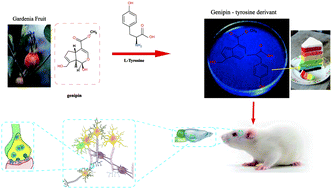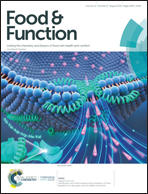Antidepressant-like effects of dietary gardenia blue pigment derived from genipin and tyrosine†
Abstract
Gardenia blue pigments derived from genipin reacting with amino acids have been used as natural food colorants for nearly 30 years in East Asia. However, their pharmacological effects, especially antidepressant-like effects, have not been reported so far. In this study, one of the gardenia blue pigments, was obtained from the reaction of genipin with tyrosine (genipin–tyrosine derivant (GTD)), and its antidepressant-like effects were investigated in lipopolysaccharide (LPS) or chronic unpredictable mild stress (CUMS) models. The results showed that GTD could attenuate depressive-like behaviors in both animal models. GTD reversed the LPS-induced cytokine increase of TNF-α, IL-6, and corticosterone (CORT) in mice plasma and hippocampus. In CUMS rats, GTD treatment significantly reduced hypothalamic-pituitary-adrenal (HPA) axis-related stress hormone levels in plasma including those of CORT, adrenocorticotropic hormone (ACTH), and corticotropin-releasing hormone (CRH). Besides, GTD increased plasma testosterone and hippocampal brain-derived neurotrophic factor (BDNF) levels in CUMS rats. GTD increased serotonin (5-HT), dopamine (DA), and norepinephrine (NE) in rat hippocampus and corpus striatum. Consistently, hippocampal metabolomic analysis demonstrated that GTD restored monoamine neurotransmitter metabolism, mitochondrial oxidative function, and membrane structural integrity. Our data suggested that GTD produced antidepressant-like activity through the restoration of the HPA axis hormone balance and the regulation of neurotransmitter release.



 Please wait while we load your content...
Please wait while we load your content...